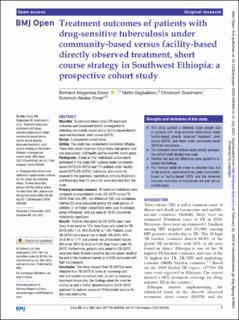Treatment outcomes of patients with drug-sensitive tuberculosis under community-based versus facility-based directly observed treatment, short course strategy in Southwest Ethiopia: a prospective cohort study
| dc.contributor.author | Ereso, Berhane Megerssa | |
| dc.contributor.author | Sagbakken, Mette | |
| dc.contributor.author | Gradmann, Christoph | |
| dc.contributor.author | Yimer, Solomon Abebe | |
| dc.coverage.spatial | Ethiopia | en_US |
| dc.date.accessioned | 2022-10-07T10:47:41Z | |
| dc.date.available | 2022-10-07T10:47:41Z | |
| dc.date.created | 2021-08-02T13:08:44Z | |
| dc.date.issued | 2021-07-21 | |
| dc.identifier.citation | BMJ Open. 2021, 11 (7), . | en_US |
| dc.identifier.issn | 2044-6055 | |
| dc.identifier.uri | https://hdl.handle.net/11250/3024481 | |
| dc.description.abstract | Objective: To compare tuberculosis (TB) treatment outcomes and associated factors among patients attending community-based versus facility-based directly observed treatment, short course (DOTS). Design: A prospective cohort study. Setting: The study was conducted in Southwest Ethiopia. There were seven hospitals (five primary, one general and one specialised), 120 health centres and 494 health posts. Participants: A total of 1161 individuals consented to participate in the study (387 patients under community-based DOTS (CB-DOTS) and 774 patients under facility-based DOTS (FB-DOTS)). Individuals who could not respond to the questions, mentally or critically ill patients, and those less than 15 years old, were excluded from the study. Primary outcome measure: TB treatment outcomes were compared among patients under CB-DOTS versus FB-DOTS. Risk ratio (RR), risk difference (RD) and confidence interval (CI) were calculated among the study groups. In addition, χ2 or Fisher’s exact tests were used to compare group differences, with a p value of <0.05 considered statistically significant. Results: Patients who opted for CB-DOTS were more likely to be cured by 12% than those who opted for FB-DOTS (RR=1.12, 95%CI=0.96 to 1.30). Patients under CB-DOTS had a lesser risk of death (RR=0.93, 95% CI=0.49 to 1.77) and a lower risk of treatment failure (RR=0.86, 95% CI=0.22 to 3.30) than those under FB-DOTS. Furthermore, patients who opted for CB-DOTS were less likely to have a positive sputum smear result at the end of the treatment period (p=0.042) compared with their counterparts. Conclusion: The study showed that CB-DOTS is more effective than FB-DOTS in terms of improving cure rate and sputum conversion rate, as well as lowering treatment failure rate. Our findings show the need for scaling up and a further decentralisation of CB-DOTS approach to improve access to TB treatment service for the rural community. | en_US |
| dc.description.sponsorship | The present study was not funded by a grant. It is a PhD project and was supported by the Strategic and Collaborative Capacity Development in Ethiopia and Africa (SACCADE) Project, the Norwegian Programme for Capacity Development in Higher Education and Research for Development (NORHAD), University of Oslo. This publication was supported by NORAD (Norwegian Agency for Development Cooperation) under the NORHED-Programme, Agreement no. ETH-13/0024. | en_US |
| dc.language.iso | eng | en_US |
| dc.publisher | BMJ Publishing Group | en_US |
| dc.relation.ispartofseries | BMJ Open;Volume 11, Issue 7 | |
| dc.rights | Navngivelse-Ikkekommersiell 4.0 Internasjonal | * |
| dc.rights.uri | http://creativecommons.org/licenses/by-nc/4.0/deed.no | * |
| dc.subject | Tuberculosis | en_US |
| dc.subject | Tuberculosis treatment outcomes | en_US |
| dc.subject | Treatment methods | en_US |
| dc.subject | Community-based treatment | en_US |
| dc.subject | Facility-based directly observed treatment | en_US |
| dc.subject | Rural communities | en_US |
| dc.title | Treatment outcomes of patients with drug-sensitive tuberculosis under community-based versus facility-based directly observed treatment, short course strategy in Southwest Ethiopia: a prospective cohort study | en_US |
| dc.type | Peer reviewed | en_US |
| dc.type | Journal article | en_US |
| dc.description.version | publishedVersion | en_US |
| dc.rights.holder | © Author(s) (or their employer(s)) 2021 | en_US |
| dc.source.articlenumber | e048369 | en_US |
| cristin.ispublished | true | |
| cristin.fulltext | original | |
| cristin.qualitycode | 1 | |
| dc.identifier.doi | http://dx.doi.org/10.1136/bmjopen-2020-048369 | |
| dc.identifier.cristin | 1923421 | |
| dc.source.journal | BMJ Open | en_US |
| dc.source.volume | 11 | en_US |
| dc.source.issue | 7 | en_US |
| dc.source.pagenumber | 1-9 | en_US |
| dc.relation.project | NORAD: ETH-13/0024 | en_US |
Tilhørende fil(er)
Denne innførselen finnes i følgende samling(er)
-
HV - Institutt for sykepleie og helsefremmende arbeid [1400]
HV - Department of Nursing and Health Promotion -
Publikasjoner fra Cristin [3269]

